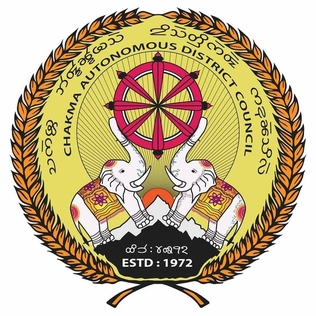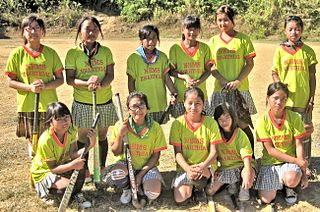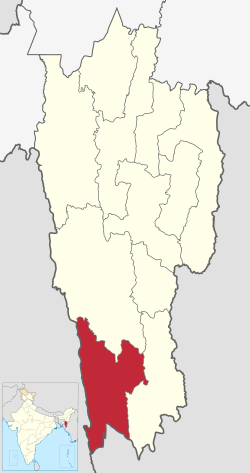
Mizoram is a state in northeast India, with Aizawl as its seat of government and capital city. The name of the state is derived from "Mizo", the endonym of the native inhabitants, and "Ram", which in the Mizo language means "land." Thus "Mizo-ram" means "land of the Mizos". Within India's northeast region, it is the southernmost landlocked state, sharing borders with three of the Seven Sister States, namely Tripura, Assam and Manipur. The state also shares a 722-kilometre (449 mi) border with the neighbouring countries of Bangladesh and Myanmar.

South Garo Hills is an administrative district in the state of Meghalaya in India. As of 2011 it is the least populous district of Meghalaya. The district was established in 1992.

Lunglei is a town, situated in the south-central part of Mizoram state, northeastern India.

Phawngpui, also known as Blue Mountain, is the highest mountain peak in the Mizo Hills and in the state of Mizoram, India, with an elevation of 2157 m. It is in Lawngtlai district, in the southeastern region of Mizoram near the Myanmar border.
Sairang is a town in the Aizawl district of the Indian state of Mizoram.

Tlabung, formerly known as Demagiri, is a census town in Lunglei district in the Indian state of Mizoram.

Lunglei district is one of the eleven districts of Mizoram state in India. As of 2011 it is the second most populous district in the state, after Aizawl.

Serchhip District is one of the eleven districts of Mizoram state in India. The district occupies an area of 1421.60 km2. Serchhip town is the administrative headquarters of the district. This district came into existence on 15 September 1998, being carved out of the larger Aizawl District. Because of the way it was created it includes part of East Lungdar Tehsil and part of Thingsulthliah Tehsil.

Siaha District is one of the eleven districts of Mizoram state in India. The district is bounded on the northwest by Lunglei district, on the north and west by Lawngtlai District and on the south and east by Myanmar. The district occupies an area of 1399.9 km2. Siaha town is the administrative headquarters of the Mara Autonomous District Council. The population had decreased from 60,823 to 56,574. It is the least populous district of Mizoram.

The Chakma Autonomous District Council (CADC) is an autonomous council for the Chakma people living in the south-western part of Mizoram, India. It covers the Tuichawng (Chawngte) subdivision of Lawngtlai district. Its headquarters is at Kamalanagar. The Chakma people has been demanding to change the status of the Chakma Autonomous District Council into a Union territory under the name Chakmaland.

Lawngtlai is the district headquarters of Lawngtlai district in the state of Mizoram in India.
Chhimtuipui District was one of the original three districts of Mizoram: Aizawl, Lunglei and Chhimtuipui. Chhimtuipui District had an area of 3,957 km2. and its headquarters was at Saiha.

Education in Mizoram consists of a diverse array of formal education systems ranging from elementary to university, from training institution to technical courses. The Government of India imposes mandatory education at least up to the basic level. For this public schools are made free of fees, and provided with free textbooks and school lunch.

The Kaladan Road Project is a US$484 million project connecting the eastern Indian seaport of Kolkata with Sittwe seaport in Rakhine State, Myanmar by sea. In Myanmar, it will then link Sittwe seaport to Paletwa in Chin State via the Kaladan river boat route, and then from Paletwa by road to Mizoram state in Northeast India. All components of the project, including Sittwe port and power, river dredging, Paletwa jetty, have been completed, except the under construction Zorinpui-Paletwa road. Originally, the project was scheduled to be completed by 2014, but end-to-end project is expected to be fully operational only by December 2023 as per November 2023 update.
Zochawchhuah, also spelt Zochachhuah, is a village on the India-Myanmar border in Lawngtlai Block of Lawngtlai district in the state of Mizoram in India. It is located 4 km south of the District headquarters Lawngtlai, 10 km from Hmawngbuchhuah, 157 km from the State capital Aizawl. It is on the east bank of the Sekulh Lui River, which marks the India-Myanmar border.
Hmawngbuchhuah is a village in Lawngtlai Block in Lawngtlai district in the state of Mizoram, India.

The following outline is provided as an overview of and topical guide to Mizoram:
Hnahthial district is one of the eleven districts of Mizoram state in India. The creation of Hnahthial District was first notified on 12 September 2008 but until 2020, it remained non-functional despite a number of promises made by top political leaders and an all-out effort by Hnahthial District Function Demand Committee to let the state government make it functional. Hnahthial district was made functional only 12 years later on 3 June 2019 with the creation of the office of the Deputy Commissioner.

The Union Territory of Mizoram, spanning from 1972 to 1987, was formed as a response to the Mizo people's demand for greater autonomy. During this time period, reforms in administration and preservation of Mizo culture started.















